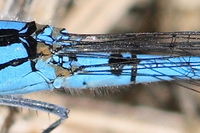- Common Blue Damselfly
-
Common Blue Damselfly 
Scientific classification Kingdom: Animalia Phylum: Arthropoda Class: Insecta Order: Odonata Suborder: Zygoptera Family: Coenagrionidae Genus: Enallagma Species: E. cyathigerum Binomial name Enallagma cyathigerum
(Charpentier, 1840)The Common Blue Damselfly or Northern Bluet (Enallagma cyathigerum) is a European damselfly.
The species can reach a length of 32 to 35 mm. It is common in all of Europe, except for Iceland.
Contents
Identification
The Common Blue Damselfly can be easily mistaken for the Azure Damselfly (Coenagrion puella), but on the back and the thorax, the Common Blue Damselfly has more blue than black; for the Azure Damselfly it is the other way around. The second segment of the thorax has a distinctive spot with a line below connecting to the third segment.
Another difference can be observed when inspecting the side of the thorax. The Common Blue Damselfly has only one small black stripe there, while all other blue damselflies have two.
During mating, the male clasps the female by her neck while she bends her body around to his reproductive organs – this is called a mating wheel. The pair flies together over the water and eggs are laid within a suitable plant, just below the surface.
The eggs hatch and the larvae, called nymphs, live in the water and feed on small aquatic animals. Nymphs climb out of the water up a suitable stem to moult into damselflies.
Behaviour
This small, brightly coloured damselfly is probably the most common of dragonflies and damselflies throughout much of Britain. It inhabits a wide range of habitats, from small ponds to rivers. They are especially common at lakes and reservoirs.
This damselfly requires a close look for a beginner to distinguish them from an Azure Damselfly. Typically, they fly low through the reeds and often fly well out over the water, unlike Azure Damselflies. They are also a brighter blue than Azures. They can be easy to get close to, but to tell them apart from an Azure Damselfly it is good to know what to look for.
See also
- Azure Damselfly, a similar looking species
- Common bluetail damselfly, an Australian damselfy which is similar in appearance
- List of British dragonflies
References
- "Common Blue Damselfly". British Dragonfly Society. http://british-dragonflies.org.uk/species/common-blue-damselfly. Retrieved 16 August 2010.
External links
 Media related to Enallagma cyathigerum at Wikimedia Commons
Media related to Enallagma cyathigerum at Wikimedia Commons Data related to Enallagma cyathigerum at Wikispecies
Data related to Enallagma cyathigerum at Wikispecies

This article related to damselflies is a stub. You can help Wikipedia by expanding it.

